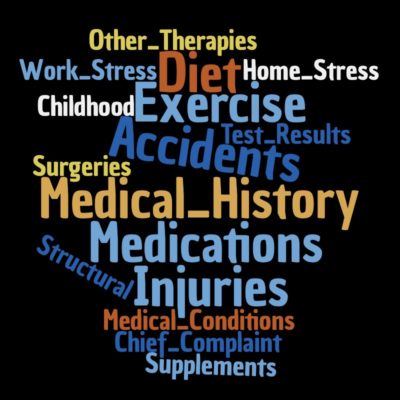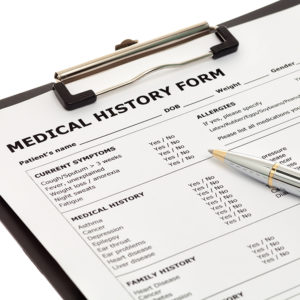When someone is in chronic pain, medical history is essential. In fact, we’ve simply never seen someone and thought, “Hmmm, I really don’t need to know this much. I wish this form was shorter…”
However, our medical history form is often just a starting point. Typically, we’ll have other conversation based on some of the things that came up in your history.
If you are in chronic pain, fully sharing your medical history with your medical providers is a really important for a good outcome.

Chronic Pain? Medical History Matters!

Chronic Pain - Medical History and Trigger Point Referrals
We can clearly see how referral patterns evoke various common pains throughout the body. Often, we initially sort out the type of headache, low back or other chronic pain from the referral pattern. Sometimes, we already have a diagnosis and use your trigger point referrals to understand it more thoroughly. Some of the factors that activate those muscles may not covered by doctors. Those activation factors are things we care a lot about.Myofascial activations are a part of most chronic pain patterns!
Spill it!
Of course, if you have a diagnosis from your doctor, we need to know. If you have recent imaging or other test results, even better! We've all been knocked around a bit. We'd like to know everything you can think of about prior accidents, injuries, surgeries and other treatments. It is important to know about previous or current medical conditions that could impact our treatment. Anything from high blood pressure to TMJD to disc problems are vital information. Hopefully, medications align with your diagnosis. Sometimes, certain medications will also modify our reatment options. Some drugs interfere with nutrient absorbtion. Increasingly, supplement use is common and we'll review that with you as well.Repetitive Use
When ever we are making repetitive movements, we should be mind of using proper body mechanics. This will help minimize repetitive stress injuries and myofascial activations. For instance, lifting in a stooped posture and then twisting is always ill-advised. Doing it repetitively is worse. Therefore, if this type of lifting is required, we should rethink the task and try to organize it in a way that reduces stooping and twisting. However, even simple movements matter. For instance, what if your desk is arranged phone on the wrong side. In fact, with every call, you have to twist your head and neck and reach over with your arm to the wrong side of the desk This is poor body mechanics. Fixing it might be as simple as moving the phone. It pays to think about basic body mechanics in this common sense way each time we engage in a repetitive activity. Fortunately, we're starting to teach this important skill to young people, as in this student guide at University of Michigan.Overload
We can experience chronic overload when we do things like wear high heels, carry a heavy bag or lean into our work. However, acute overload happens when we decide to lift, push, pull or otherwise move something that is too heavy for us. Most often, we overload our muacles with an eccentric contraction. For example, lifting a heavy box, correctly using your legs instead of your back, requires concentric contractions of your quads. However, setting that same heavy box down, slowly and with control, require eccentric, lengthening contractions. These should be done carefully.We usually discuss diet and common, legal substance use, such as alcohol, tobacco and cannabis.
Sometimes, home is a refuge; a place for us to rest and repair. However, other times, our household and family demands are challenging. Either way, we're interested in how you use your body at home. How active are you? How do you relax? What type of furniture do you have?
Good sleep is incredibly important. Everything from sleep position to how deep your sleep is will affect how you recover from pain.
Finally we review recreation habits, exercise and fitness goals in detail. This helps us tailor our treatment and self-care recommendations effectively.
